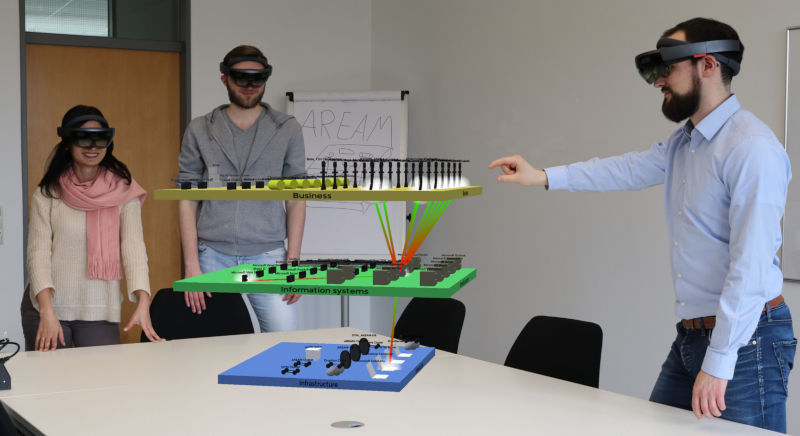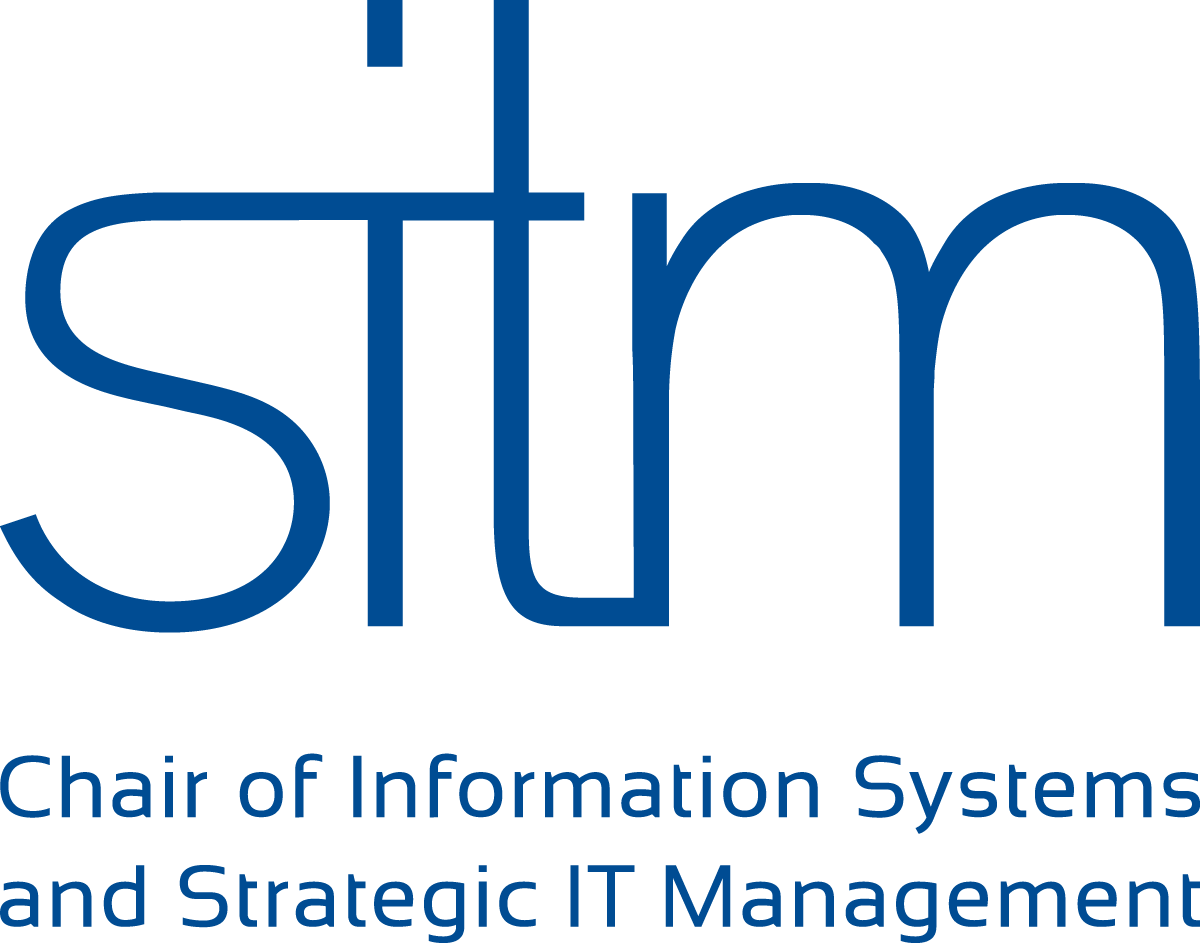Augmented Reality-enabled Enterprise Architecture Management
Augmented Reality-enabled Enterprise Architecture Management


Enterprise Architecture Management (EAM) is a management discipline that provides a wide range of processes, methods, models, and tools to symbiotically manage an organization’s IT and business structure [1–3]. Organizations develop Enterprise Architecture (EA) artefacts that describe their current and possible future states to help stakeholders make decisions [4, 5]. Examples of EA artifacts are: business strategies, process models, standards, data flow diagrams, network diagrams, and roadmaps [6]. EA artifacts are considered useful for a better decision quality [5, 7].
However, current investigations show low usage of EA artifacts in decision making [8, 9, 7]. In sum, researchers report that stakeholders perceive EA artifacts as too complex [10], containing unnecessary information [11], or as too abstract [12, 13]. Insufficient tool support [12] and poor collaboration between stakeholders [14] also foster the inefficient use of EA artifacts.
We want to address these challenges by proposing applying augmented reality (AR) to visualize and interact with EA artifacts and as an intuitive and easy-to-use approach to EA decision making. AR combines the real and the virtual world by displaying virtual objects in a real-world scenario by, for example, using a head-mounted display (HMD), or a smartphone [15–17]. AR takes a decision maker’s spatial ability into account, which decreases his or her cognitive load, thus enabling a better overall understanding of complex causal relationships [17–19]. The following figure shows the current status of the prototype.

Research questions
We address the novel idea of combining AR and EAM to enhance EA decision-making in organizations by asking the following research questions:
- What are the benefits of augmented reality for EAM?
- What should an augmented reality-enabled EAM user interface look like?
- How can organizations implement AR for EAM?
- How can AR EAM become an accepted EAM tool?
Duration
2017 – 2020
Publications
- Rehring, K.; Ahlemann, F.: Evaluating the User Experience of an Augmented Reality Prototype for Enterprise Architecture. In: WI 2020. Potsdam. 2020. DetailsBIB Download
- Rehring, K.; Brée, T.; Gulden, J.; Bredenfeld, L.: CONCEPTUALIZING EA CITIES: TOWARDS VISUALIZING ENTERPRISE ARCHITECTURES AS CITIES. In: Proceedings of the 27th European Conference on Information Systems (ECIS). Stockholm & Uppsala, Sweden, 2019. KurzfassungDetailsVolltextBIB Download
Enterprise Architectures (EAs) are commonly visualized in the form of text, numbers, tables, graphs, models, and diagrams. These information visualization types are used to describe EAs in today’s organizations, but often lack an intuitive representation. In this paper, we provide another form of EA visualization utilizing the city metaphor. This spatial metaphor is suitable for visualizing complex information structures and potentially facilitates easy understanding of EAs, especially for non-IT staff. Based on a literature review and three rounds of open card sorting, we mapped eleven classes of EA objects to city elements. Our results enabled us to develop a formal language that allows an implementable and human-readable specification of various views, which we call EA City. We created an early stage 3D EA City prototype to demonstrate its applicability. Our model provides a solid foundation for further work on the city metaphor in the context of EA visualization.
- Rehring, K.; Hoffmann, D.; Ahlemann, F.: Put your glasses on: Conceptualizing affordances of mixed and virtual reality for enterprise architecture management. In: Multikonferenz Wirtschaftsinformatik (MKWI). Lüneburg, Germany , 2018. DetailsBIB Download
- Rehring, K.; Greulich, M.; Bredenfeld, L.; Ahlemann, F.: Let’s get in touch - Decision making about Enterprise Architecture using 3D Visualization in Augmented Reality. In: Proceedings of the 52nd annual Hawaii International Conference on Systems Science. Hawaii, USA, 2019. KurzfassungDetailsBIB Download
Making informed decisions about historically grown and often complex business and Information Technology (IT) landscapes can be particularly difficult. Enterprise Architecture Management (EAM) addresses this issue by enabling stakeholders to base their decisions on relevant information about the organization’s current and future Enterprise Architectures (EAs). However, visualization of EA is often confronted with low usefulness perceptions. Informed by the cognitive fit theory (CFT), we argue that decision-makers benefit from interacting with EA visualizations using Augmented Reality (AR), because it enables a consistent task-related mental representation based on the natural use of decision-makers’ visual-spatial abilities. The goal of this paper is to demonstrate ARs suitability for EA-related decision-making. We follow the design science research (DSR) approach to develop and evaluate an AR head-mounted display (HMD) prototype, using the Microsoft HoloLens. Our results suggest that EA-related decision-making can profit from applying AR, but users find the handling of the HMD device cumbersome.
References
- Ahlemann, F., Stettiner, E., Messerschmidt, M., Legner, C.: Strategic Enterprise Architecture Management: Challenges, Best Practices, and Future Developments. Springer, Berlin ; New York (2012).
- Aier, S., Gleichauf, B., Winter, R.: Understanding Enterprise Architecture Management Design – An Empirical Analysis. In: Wirtschaftsinformatik Proceedings 2011 (2011).
- Simon, D., Fischbach, K., Schoder, D.: Enterprise architecture management and its role in corporate strategic management. Information Systems and e-Business Management. 12, 5–42 (2014).
- Opengroup: TOGAF Version 9. Van Haren Publishing (2009).
- Tamm, T., Seddon, P.B., Shanks, G., Reynolds, P.: How does enterprise architecture add value to organisations. Communications of the Association for Information Systems. 28, 141–168 (2011).
- Kotusev, S., Singh, M., Storey, I.: Investigating the Usage of Enterprise Architecture Artifacts. ECIS 2015 Research-in-Progress Papers. (2015).
- Hiekkanen, K., Korhonen, J.J., Collin, J., Patricio, E., Helenius, M., Mykk\änen, J.: Architects’ Perceptions on EA Use – An Empirical Study. In: 2013 IEEE 15th Conference on Business Informatics. pp. 292–297 (2013).
- Löhe, J., Legner, C.: Overcoming implementation challenges in enterprise architecture management: a design theory for architecture-driven IT Management (ADRIMA). Information Systems and e-Business Management. 12, 101–137 (2014).
- Abraham, R.: Enterprise Architecture Artifacts as Boundary Objects-A Framework of Properties. ECIS 2013 Proceedings. (2013).
- van der Raadt, B., Schouten, S., Vliet, H. van: Stakeholder Perception of Enterprise Architecture. In: Morrison, R., Balasubramaniam, D., and Falkner, K. (eds.) Software Architecture. pp. 19–34. Springer Berlin Heidelberg (2008).
- Buckl, S., Ernst, A.M., Matthes, F., Schweda, C.M.: How to make your enterprise architecture management endeavor fail! Presented at the Proceedings of the 16th Conference on Pattern Languages of Programs (2009).
- Nowakowski, E., Farwick, M., Trojer, T., Häusler, M., Kessler, J., Breu, R.: Enterprise Architecture Planning: Analyses of Requirements from Practice and Research. Hawaii International Conference on System Sciences 2017 (HICSS-50). (2017).
- Vieira, R., Cardoso, E., Becker, C.: A Traceable Maturity Assessment Method Based on Enterprise Architecture Modelling. Presented at the 18th International Enterprise Distributed Object Computing Conference Workshops and Demonstrations September (2014).
- Banaeianjahromi, N., Smolander, K.: Lack of Communication and Collaboration in Enterprise Architecture Development. Information Systems Frontiers. (2017).
- Azuma, R.T.: A survey of augmented reality. Presence: Teleoperators and virtual environments. 6, 355–385 (1997).
- Milgram, P., Takemura, H., Utsumi, A., Kishino, F.: Augmented Reality: A class of displays on the reality-virtuality continuum. Telemanipulator and telepresence technologies. 2351, 282–292 (1994).
- Rehman, U., Cao, S.: Augmented-Reality-Based Indoor Navigation: A Comparative Analysis of Handheld Devices Versus Google Glass. IEEE Transactions on Human-Machine Systems. 140–151 (2016).
- Sommerauer, P., Müller, O.: Augmented reality in informal learning environments: A field experiment in a mathematics exhibition. Computers & Education. 79, 59–68 (2014).
- Wang, X., Love, P.E.D., Kim, M.J., Wang, W.: Mutual awareness in collaborative design: An Augmented Reality integrated telepresence system. Computers in Industry. 65, 314–324 (2014).


